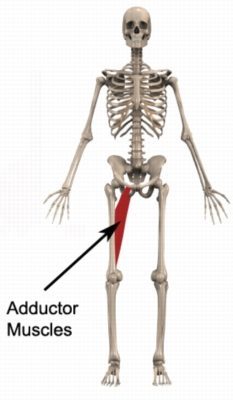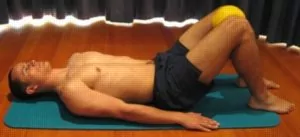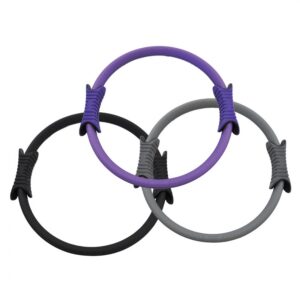Groin Strain
Updated:
(Also known as Groin Strain, Strained Groin, Pulled Groin, Groin Tear, Torn Groin, Adductor Strain, Torn Adductor Muscle, Adductor Tear)
What is a groin strain?
A groin strain is a relatively common condition characterized by tearing of some or all of the adductor muscle group (groin muscles – figure 1).

The muscles at the inner aspect of your thigh are known as the adductor muscles (groin). These muscles originate from the pelvis and insert into the inner aspect of the thigh (femur) and lower leg bones (figure 1).
The groin muscles are responsible for stabilising the pelvis and moving the leg towards the midline of the body (adduction). They are particularly active during running (especially when changing direction) and kicking.
During contraction of the groin muscles, tension is placed through the groin. When this tension is excessive due to too much repetition or high force, one or more of the groin muscles can tear. This is known as a groin strain and can range from a small partial tear of the groin muscle(s) whereby there is minimal pain and minimal loss of function, to a complete rupture of one or more groin muscles resulting in severe pain and marked loss of function. Groin strains range from a grade 1 to a grade 3 strain and are classified as follows:
- Grade 1: a small number of muscle fibres are torn resulting in some pain but allowing full function.
- Grade 2: a significant number of muscle fibres are torn with moderate loss of function.
- Grade 3: all muscle fibres are ruptured resulting in major loss of function.
The majority of groin strains are grade 2. The most commonly affected muscle involved in a strained groin is the adductor longus muscle.
Causes of a groin strain
A groin strain commonly occurs due to a sudden contraction of the groin muscles often when they are in a position of stretch. This typically occurs during rapid acceleration whilst running (particularly when changing direction) or when a footballer performs a long kick. They are commonly seen in running sports such as football, hockey and athletics (particularly sprinters, hurdlers, and long jumpers) as well as skiing, horse riding and gymnastics. Groin strains tend to occur more commonly in the older athlete and particularly following an inadequate warm-up.
Signs and symptoms of a groin strain
Patients with this condition usually feel a sudden sharp pain or pulling sensation in the inner thigh or groin during the provocative activity. In minor cases, the patient may be able to continue the activity only to have an increase in symptoms upon cooling down. In more severe cases, the patient may be unable to continue the activity and will often limp or be unable to walk off the playing field.
Patients with a groin strain usually experience an increase in pain during activities which place load on the groin muscles. These activities may include: walking (especially on uneven surfaces or stairs), running (especially changing directions), twisting, jumping, and kicking. It is also common for patients with this condition to experience pain or stiffness after these activities with rest, especially upon waking in the morning. Squeezing the legs together and performing a groin stretch (figure 3) may also cause pain in patients with a groin strain.
Patients with this condition may also experience swelling, muscle spasm, weakness, tightness, tenderness and bruising in the inner aspect of the thigh and groin.
Diagnosis of a groin strain
A thorough subjective and objective examination from a physiotherapist is usually sufficient to diagnose a strained groin. Further investigations such as an MRI scan or Ultrasound may be required, in rare cases, to confirm diagnosis and assess the severity of injury.
Treatment for a groin strain

Members Only ContentBecome a PhysioAdvisor Member to gain full access to this exclusive content. For more details see Become a Member. Already a member? Login Now
Prognosis of a groin strain
With appropriate management, patients with minor groin strains can usually recover in one to three weeks. With larger tears, recovery may take four to six weeks or longer, depending on the severity. In cases of a complete rupture of the groin, long term weakness and reduced function may occur.
Contributing factors to the development of a groin strain
There are several factors which can predispose patients to developing a groin strain. These need to be assessed and corrected with direction from a physiotherapist. Some of these factors include:
- poor groin flexibility
- muscle weakness (especially of the groin or gluteals)
- inadequate conditioning of the groin muscles
- muscle tightness
- inappropriate training or technique
- poor biomechanics
- poor posture
- decreased fitness
- fatigue
- inadequate warm up
- joint stiffness (particularly the lower back, hip and knee)
- poor pelvic and core stability
- inadequate rehabilitation following a previous groin injury
- neural tightness
- muscle imbalances
Physiotherapy for a groin strain
Physiotherapy for patients with this condition is vital to hasten the healing process, ensure an optimal outcome and reduce the likelihood of future recurrence. Treatment may comprise:
- soft tissue massage
- electrotherapy (e.g. ultrasound)
- stretches
- muscle energy techniques
- joint mobilization
- ice or heat treatment
- the use of a compression bandage or strapping
- education
- biomechanical correction
- the use of crutches
- dry needling
- progressive exercises to improve strength, flexibility, core stability, pelvic stability and balance
- activity modification advice
- technique correction
- anti-inflammatory advice
- prescription of orthotics
- devising and monitoring a return to sport or activity plan
Other intervention for a groin strain
Despite appropriate physiotherapy management, some patients with a strained groin do not improve adequately. When this occurs, the treating physiotherapist or doctor can advise on the best course of management. This may include investigations such as an X-ray, ultrasound, CT scan or MRI, or referral to appropriate medical authorities who can advise on any intervention that may be appropriate to improve the condition. In very rare cases, of complete groin rupture, surgical intervention may be considered.
Exercises for a groin strain
The following exercises are commonly prescribed to patients with this condition. You should discuss the suitability of these exercises with your physiotherapist prior to beginning them. Generally, they should be performed 3 times daily and only provided they do not cause or increase symptoms.
Your physiotherapist can advise when it is appropriate to begin the initial exercises and eventually progress to the intermediate and advanced exercises. As a general rule, addition of exercises or progression to more advanced exercises should take place provided there is no increase in symptoms.
Initial Exercises
Groin squeezes
Begin this exercise by lying in the position demonstrated with a rolled towel or ball between your knees (figure 2). Slowly squeeze the ball between your knees tightening your groin muscles (adductors). Hold for 5 seconds and repeat 10 times as hard as possible pain free.

Groin Stretch
Begin this exercise by standing tall with your back straight and your feet approximately twice shoulder width apart. Gently lunge to one side, keeping the other knee straight, until you feel a stretch in the groin (figure 3). Hold for 5 seconds and repeat 10 times at a mild to moderate stretch provided the exercise is pain free.

Intermediate Exercises

Members Only ContentBecome a PhysioAdvisor Member to gain full access to this exclusive content. For more details see Become a Member. Already a member? Login Now
Advanced Exercises

Members Only ContentBecome a PhysioAdvisor Member to gain full access to this exclusive content. For more details see Become a Member. Already a member? Login Now
Rehabilitation Protocol for a groin strain

Members Only ContentBecome a PhysioAdvisor Member to gain full access to this exclusive content. For more details see Become a Member. Already a member? Login Now
Physiotherapy products for a groin strain
Some of the most commonly recommended products by physiotherapists to hasten healing and speed recovery in patients with a groin strain include:
To purchase physiotherapy products for a strained groin click on one of the above links or visit the PhysioAdvisor Shop.
Find a Physio for a groin strain
Find a physiotherapist in your local area who can treat a groin strain.
Other Exercises
- View more Groin Stretches.
- View more Groin Strengthening Exercises.
- View Balance Exercises.
- View more Hip Flexibility Exercises.
- View more Hip Strengthening Exercises.
- View Beginner Pilates Exercises to improve core stability and posture.
- View detailed information on initial injury management and the R.I.C.E. regime.
- View detailed information on How to use Crutches.
- View detailed information on when to use Ice or Heat.
- View detailed information on a Return to Running Program.
Become a PhysioAdvisor Member
-
 Individual Membership (12 Months)$59.95 for 1 year
Individual Membership (12 Months)$59.95 for 1 year -
 Individual Membership (3 Months)$39.95 for 3 months
Individual Membership (3 Months)$39.95 for 3 months -
 Individual Membership (Yearly)$49.95 / year
Individual Membership (Yearly)$49.95 / year -
 Individual Membership (Monthly)$15.95 / month
Individual Membership (Monthly)$15.95 / month

Link to this Page
If you would like to link to this article on your website, simply copy the code below and add it to your page:
<a href="https://physioadvisor.com.au/injuries/hip-groin/groin-strain”>Groin Strain – PhysioAdvisor.com</a><br/>Get detailed information on groin strain (adductor strain) including causes, signs and symptoms, diagnosis, treatment, exercises and more at PhysioAdvisor.
Return to the top of Groin Strain.








